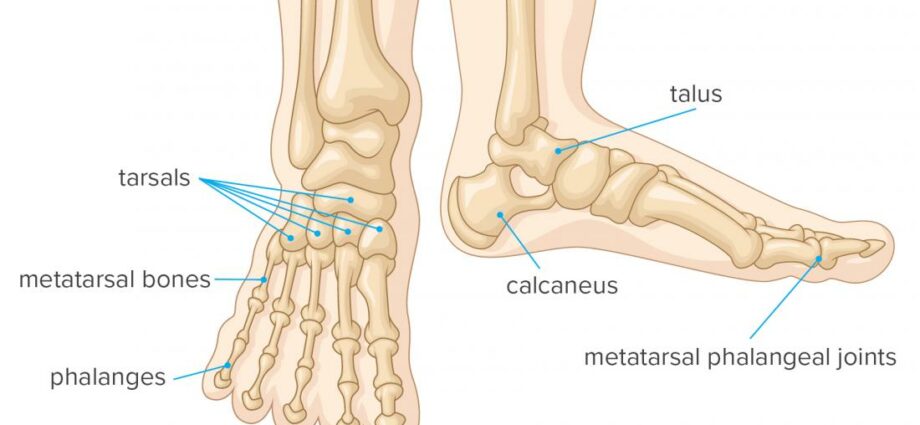Contents
Foot bones
Foot anatomy
Structure. The twenty-six bones of the foot are grouped into several parts: the tarsus, metatarsus and phalanges. (1)
Tarse. It is made up of seven bones:
- The talus is the only bone that articulates with the bones of the leg, tibia, and fibula (also known as the fibula). It also articulates with the navicular bone and the calcaneus.
- The calcaneus is the strongest and largest bone in the foot. It articulates with the talus and cuboid bone, located at the front.
- The three cuneiform bones are distinguished by their positions. The larger medial cuneiform and the smaller intermediate cuneiform articulate with the navicular bone behind and the metatarsal in front. The lateral cuneiform articulates mainly with the cuboid bone as well as with the metatarsal and navicular bone.
- The navicular bone is a flattened barque-shaped bone. Placed towards the medial face, it is located between the talus at the back and the three cuneiform bones at the front.
- Cuboid bone is a cubic shaped bone placed towards the lateral face. It is located between the calcaneus in the back and the metatarsus in the front.
The metatarsus. It is made up of five bones. The first metatarsal bone is the strongest and smallest while the second is the longest. The proximal bases of the 1st, 2nd and 3rd bone articulate with the three cuneiform bones while the proximal bases of the 4th and 5th bone articulate with the cuboid bone.
Phalanges. The skeleton of the foot is made up of fourteen phalanges. The 1st, commonly referred to as the big toe, is made up of only two phalanges while the other four toes are made up of three phalanges.
The entire skeleton of the foot is maintained thanks in particular to the numerous joints and ligaments.
Foot physiology
Body weight support. One of the main functions of the bones of the foot is to support the weight of the body. (2)
Static and dynamic of the foot. The skeleton of the foot maintains the support of the body and also performs various movements including propulsion of the body when walking. (2) (3)
Foot pathologies
Foot bone fractures. The skeleton of the foot can be the site of fractures, the most frequent of which are those of the bones of the metatarsal and calcaneus. (4)
Anomalies. The foot is the site of abnormalities, especially bones, due to malformations or following fractures or immobilization. Within these anomalies we find in particular the hollow foot, the varus foot, the flat foot, the club foot, or the equine foot. (4)
Maladies of the os. Many diseases can affect the bones and change their structure. Osteoporosis is one of the most common conditions. It consists of a loss of bone density in people, usually elderly, who are then exposed to bone fragility and fractures.
Foot treatments and prevention
Medical treatment. Depending on the disease, different treatments may be prescribed to regulate or strengthen bone tissue or reduce pain and inflammation.
Surgical treatment. Depending on the type of fracture, a surgical operation can be carried out with the installation of a screw-retained plate, nails or even an external fixator.
Orthopedic treatment. Depending on the type of fracture, a plaster cast may be performed.
Foot exams
Medical imaging examination. X-ray, CT, MRI, scintigraphy or bone densitometry examinations can be used to assess bone pathologies.
Medical analysis. In order to identify certain pathologies, blood or urine analyzes can be carried out such as, for example, the dosage of phosphorus or calcium.
History and symbolism of the foot
“Little Foot” (in French, petit pied) is the name given to a skeleton ofAustralopithecus prometheus discovered in 1994 by paleoanthropologist Ronald J. Clarke. It owes its name “Little Foot” to the small size of the foot bones initially found in a box of bones classified as coming from bovines. After the discovery of these small foot bones, the researchers found 90% of the skeleton: “Little Foot” thus became the most complete Australopithecus skeleton discovered to date. After highly variable dating results, a new method has made it possible to date it to 3,67 million years old (5) (6).










